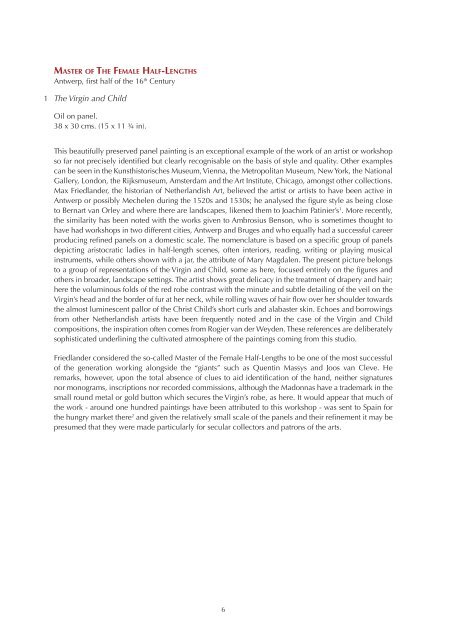Catalogue-2014-Jean-Luc-Baroni
- No tags were found...
Create successful ePaper yourself
Turn your PDF publications into a flip-book with our unique Google optimized e-Paper software.
Master of The Female Half-Lengths<br />
Antwerp, first half of the 16 th Century<br />
1<br />
The Virgin and Child<br />
Oil on panel.<br />
38 x 30 cms. (15 x 11 ¾ in).<br />
This beautifully preserved panel painting is an exceptional example of the work of an artist or workshop<br />
so far not precisely identified but clearly recognisable on the basis of style and quality. Other examples<br />
can be seen in the Kunsthistorisches Museum, Vienna, the Metropolitan Museum, New York, the National<br />
Gallery, London, the Rijksmuseum, Amsterdam and the Art Institute, Chicago, amongst other collections.<br />
Max Friedlander, the historian of Netherlandish Art, believed the artist or artists to have been active in<br />
Antwerp or possibly Mechelen during the 1520s and 1530s; he analysed the figure style as being close<br />
to Bernart van Orley and where there are landscapes, likened them to Joachim Patinier’s 1 . More recently,<br />
the similarity has been noted with the works given to Ambrosius Benson, who is sometimes thought to<br />
have had workshops in two different cities, Antwerp and Bruges and who equally had a successful career<br />
producing refined panels on a domestic scale. The nomenclature is based on a specific group of panels<br />
depicting aristocratic ladies in half-length scenes, often interiors, reading, writing or playing musical<br />
instruments, while others shown with a jar, the attribute of Mary Magdalen. The present picture belongs<br />
to a group of representations of the Virgin and Child, some as here, focused entirely on the figures and<br />
others in broader, landscape settings. The artist shows great delicacy in the treatment of drapery and hair;<br />
here the voluminous folds of the red robe contrast with the minute and subtle detailing of the veil on the<br />
Virgin’s head and the border of fur at her neck, while rolling waves of hair flow over her shoulder towards<br />
the almost luminescent pallor of the Christ Child’s short curls and alabaster skin. Echoes and borrowings<br />
from other Netherlandish artists have been frequently noted and in the case of the Virgin and Child<br />
compositions, the inspiration often comes from Rogier van der Weyden. These references are deliberately<br />
sophisticated underlining the cultivated atmosphere of the paintings coming from this studio.<br />
Friedlander considered the so-called Master of the Female Half-Lengths to be one of the most successful<br />
of the generation working alongside the “giants” such as Quentin Massys and Joos van Cleve. He<br />
remarks, however, upon the total absence of clues to aid identification of the hand, neither signatures<br />
nor monograms, inscriptions nor recorded commissions, although the Madonnas have a trademark in the<br />
small round metal or gold button which secures the Virgin’s robe, as here. It would appear that much of<br />
the work - around one hundred paintings have been attributed to this workshop - was sent to Spain for<br />
the hungry market there 2 and given the relatively small scale of the panels and their refinement it may be<br />
presumed that they were made particularly for secular collectors and patrons of the arts.<br />
6
















